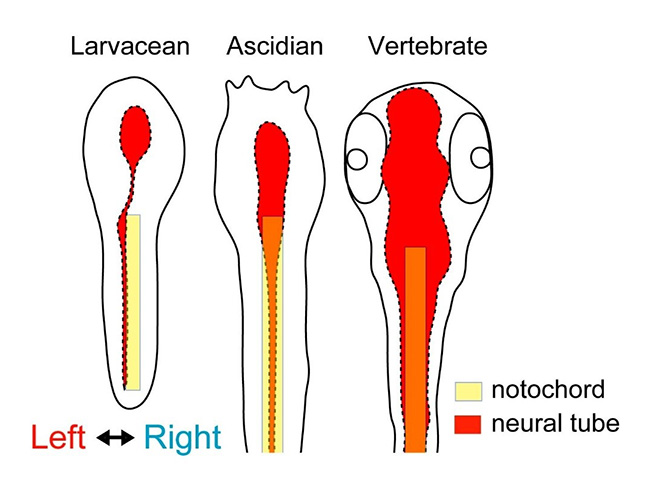Figure
The nerve cord is located on the left, not dorsal, side of the larvacean. Dorsal views of tadpole larva of larvacean, ascidian, and vertebrate affinities. Notochord and neural tube are shown in yellow and red, respectively.
A tadpole with a twist: Left–right asymmetric development of Oikopleura dioica
How does a developing embryo, which is initially round, tell left from right? This basic process is still poorly understood. However, investigating unusual cases can help shed light on how this process occurs in animals. More than a century ago, German biologist Dr. H. C. Delsman described unusual left–right (L–R) patterning in the tadpole-like tunicate
Bilateral symmetry is one the most fundamental characteristics of members of the phylum Chordata, the group that includes O. dioica as well as all animals with backbones, although L–R patterning tends to emerge later in development. However, in the larvacean tunicate O. dioica, distinct fronm other chordates, L–R asymmetry first appears in the four-cell embryo stage and persists throughout development; the nerve cord, typically located on the dorsal side of chordates, forms instead on the animal’s left side. This notable difference provides an opportunity to investigate the mechanisms that drive L–R patterning in chordates.
“Our study reveals that this larvacean uses calcium ion oscillation and expression of the right-sided bone morphogenetic protein (Bmp) gene for embryonic left–right patterning,” explains first author Takeshi A. Onuma. “Intriguingly, Nodal, an evolutionarily conserved left-determining gene found in other chordates, is absent from the genome of O. dioica. As the larvacean develops, it is likely that its tail twists 90° counterclockwise relative to its trunk, with the tail nerve cord localized on its left side.”
In most chordates, Nodal and Bmp create the gradient responsible for L–R determination in the developing embryo. The absence of Nodal, combined with the novel and early L–R patterning of this larvacean, is therefore of great interest for advancing understanding of the roles of Nodal, Bmp, and calcium ion oscillation, and the evolution of L–R patterning in early chordates.
According to senior author Hiroki Nishida, “between insects and vertebrates, the dorsal–ventral axis is inverted 180°, which is correlated with Bmp expression. However, the reason for this inversion is not yet well understood. In addition to revealing a novel left–right patterning process of a chordate species, our findings provide an example where the dorsal–ventral axis and Bmp expression lead to 90° rotation with left–right patterning.”
Such examples of novel L–R patterning are key for unraveling some of the most fundamental questions about the earliest evolution and development of chordates and other animals.

The article, “A chordate species lacking Nodal utilizes calcium oscillation and Bmp for left–right patterning,” was published in the Proceedings of the National Academy of Sciences at DOI: https://doi.org/10.1073/pnas.1916858117.
Related links









